Table of Contents
- History and Origin of the Samoyed Breed
- Appearance and Physical Characteristics of Samoyed Dogs
- Temperament and Personality Traits of Samoyeds
- Caring for Your Samoyed: Exercise, Grooming, and Health
- Training Your Samoyed: Tips and Techniques for Success
- Samoyed Socialization: How to Help Your Dog Thrive
- Samoyeds and Children: A Match Made in Heaven?
- Samoyeds in Pop Culture and Beyond
- Finding Your Perfect Samoyed: Adoption, Breeder, or Rescue?
History and Origin of the Samoyed Breed
The Samoyed breed is a type of spitz dog that is believed to have originated in Siberia, Russia, over 3,000 years ago. These dogs were traditionally used by the Samoyede people, who were semi-nomadic reindeer herders in the arctic regions of Siberia.
Early Use
Samoyeds were bred to assist their owners with a wide range of tasks, including herding reindeer, hunting, and hauling sleds across long distances. They were also used to provide warmth to their owners during the harsh Siberian winters, as they were allowed to sleep in the same tents as their human companions.
Introduction to Europe
The Samoyed breed was first introduced to Europe in the late 1800s when explorers and traders began bringing the dogs back from Siberia. The breed quickly gained popularity among European aristocrats and royalty due to their striking appearance and charming temperament.
Recognition as a Breed
In 1909, the Samoyed breed was officially recognized by the American Kennel Club (AKC) and the Kennel Club in the UK. Today, the Samoyed breed is still widely used as a working dog in Arctic regions and is also a popular companion animal in many parts of the world.
Unique Characteristics
The Samoyed breed is known for its distinctive appearance, including a thick white coat and a plumed tail that curves over the back. They are also known for their friendly and sociable personalities, which make them excellent family pets.
Conclusion
The history and origin of the Samoyed breed is a testament to their resilience and adaptability in harsh arctic environments. Today, these dogs are beloved companions around the world and continue to thrive in their traditional roles as working dogs in the Arctic regions of Siberia.

Appearance and Physical Characteristics of Samoyed Dogs
Samoyed dogs are known for their striking appearance, which includes a thick, white, double-layered coat and dark, almond-shaped eyes. Here are some more details about the physical characteristics of Samoyed dogs.
Coat
One of the most distinctive features of Samoyed dogs is their thick, white coat, which is made up of a soft, dense undercoat and a longer, coarser outer coat. This double-layered coat provides insulation from the cold and also sheds water, which makes Samoyeds well-suited for living in Arctic regions. The coat requires regular grooming to prevent matting and to keep it looking its best.
Size and Proportion
Samoyed dogs are a medium-sized breed, with males typically standing between 21 and 23.5 inches tall at the shoulder and weighing between 45 and 65 pounds. Females are slightly smaller, standing between 19 and 21 inches tall and weighing between 35 and 50 pounds. Samoyed dogs have a sturdy, well-proportioned build that is both strong and agile.
Head and Facial Features
The head of a Samoyed dog is wedge-shaped and proportionate to the body. They have a strong, broad muzzle and a well-defined stop between the muzzle and the forehead. The ears are small, erect, and slightly rounded at the tips. Samoyed dogs have dark, almond-shaped eyes that are set well apart and convey a friendly expression.
Movement and Gait
Samoyed dogs have a distinctive gait that is characterized by a smooth, effortless movement. When they walk or run, they have a bounding, springy stride that is both powerful and graceful. Their movement is efficient and purposeful, making them well-suited for their traditional roles as working dogs.
Conclusion
Samoyed dogs have a unique and striking appearance that makes them instantly recognizable. From their thick, white coat to their dark, almond-shaped eyes, every aspect of their physical appearance has been shaped by their history and environment. Despite their striking appearance, however, Samoyed dogs are much more than just a pretty face – they are intelligent, loyal, and affectionate companions that make wonderful family pets.
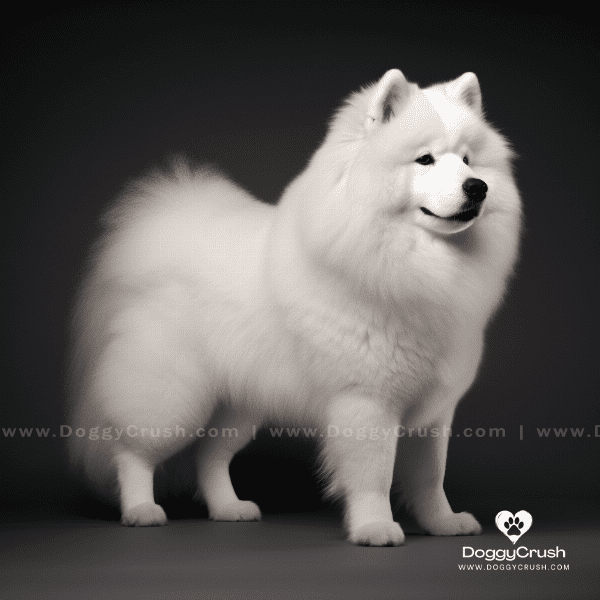
Temperament and Personality Traits of Samoyeds
Samoyed dogs are known for their friendly and affectionate personalities, which make them wonderful family pets. Here are some more details about the temperament and personality traits of Samoyed dogs.
Friendly and Sociable
Samoyed dogs are known for their friendly and sociable personalities. They love people and thrive on human interaction, which makes them excellent family pets. They are also generally good with other dogs and pets, although socialization is important to ensure they get along well with others.
Energetic and Playful
Samoyed dogs are a high-energy breed that loves to play and be active. They are happiest when they have plenty of opportunities to exercise and explore their surroundings. Samoyeds enjoy playing games, such as fetch and tug-of-war, and they are also well-suited for activities like hiking and running.
Intelligent and Trainable
Samoyed dogs are intelligent and trainable, which makes them well-suited for a variety of tasks. They respond well to positive reinforcement training techniques, such as clicker training and reward-based training. Samoyeds are also eager to please their owners, which makes training a fun and rewarding experience.
Alert and Watchful
Samoyed dogs are naturally alert and watchful, which makes them good watchdogs. They will bark to alert their owners of any potential dangers, but they are not typically aggressive or overly protective. Samoyeds are generally friendly with strangers, which makes them better suited to being watchdogs rather than guard dogs.
Conclusion
Samoyed dogs have a wonderful temperament that makes them well-suited for a variety of environments. From their friendly and sociable personalities to their energetic and playful nature, every aspect of their personality has been shaped by their history and environment. Despite their many positive traits, however, it is important to remember that Samoyeds are individuals and their personalities may vary from dog to dog.

Caring for Your Samoyed: Exercise, Grooming, and Health
Samoyed dogs require regular exercise, grooming, and veterinary care to ensure they stay healthy and happy. Here are some tips for caring for your Samoyed.
Exercise
Samoyed dogs are a high-energy breed that requires daily exercise to stay healthy and happy. They enjoy activities like hiking, running, and playing games with their owners. Samoyeds also enjoy mental stimulation, so activities like puzzle toys and obedience training can be beneficial for them.
Grooming
Samoyed dogs have a thick, double-layered coat that requires regular grooming to prevent matting and maintain its appearance. They should be brushed at least once a week, and more frequently during shedding season. Samoyeds also require occasional baths to keep their coat clean and healthy.
Health
Samoyed dogs are generally healthy, but like all breeds, they are prone to certain health issues. Some common health concerns for Samoyeds include hip dysplasia, eye problems, and allergies. It is important to schedule regular veterinary check-ups for your Samoyed to catch any potential health issues early.
Nutrition
Samoyed dogs require a high-quality diet that is formulated for their specific nutritional needs. It is important to feed your Samoyed a diet that is high in protein and low in fat to maintain their optimal weight and muscle mass. Your veterinarian can recommend a diet that is right for your Samoyed.
Conclusion
Caring for a Samoyed dog requires regular exercise, grooming, and veterinary care. By providing your Samoyed with the right care, you can help them stay healthy and happy for years to come.
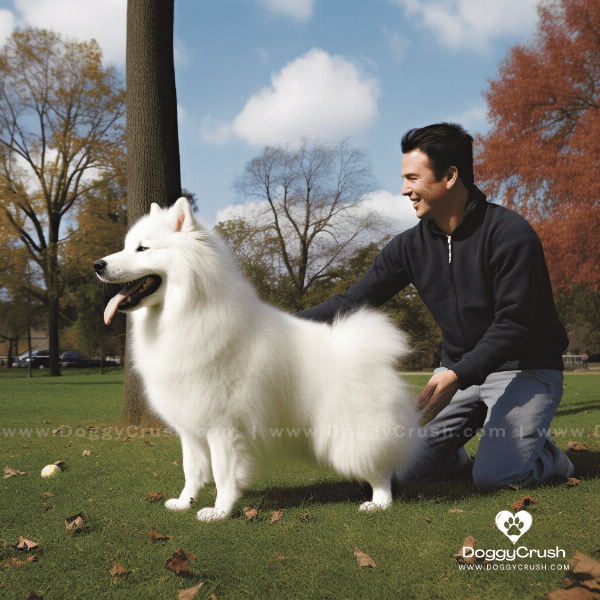
Training Your Samoyed: Tips and Techniques for Success
Training a Samoyed dog requires patience, consistency, and positive reinforcement. Here are some tips and techniques for successful Samoyed training.
Positive Reinforcement
Samoyeds respond best to positive reinforcement training techniques. This means rewarding your dog with treats, praise, and play for good behavior, rather than punishing them for bad behavior. Positive reinforcement training helps build a strong bond between you and your Samoyed and makes training a fun and rewarding experience.
Consistency
Consistency is key when training a Samoyed. Your dog needs clear, consistent cues and expectations to understand what you want them to do. Use the same cues for each behavior, and be consistent with your expectations and rewards. This will help your Samoyed understand what is expected of them and how to earn rewards.
Socialization
Socialization is an important part of Samoyed training. Exposing your dog to a variety of people, animals, and environments from a young age will help them develop good social skills and reduce the risk of behavior problems. Gradually expose your Samoyed to new experiences and make them a positive experience through rewards and positive reinforcement.
Obedience Training
Obedience training is an important part of Samoyed training. Basic commands such as “sit,” “stay,” “come,” and “heel” are essential for keeping your Samoyed safe and well-behaved. Start with basic obedience training and gradually increase the difficulty of the commands as your Samoyed progresses.
Conclusion
Training a Samoyed dog requires patience, consistency, and positive reinforcement. By using positive reinforcement, consistency, and socialization techniques, you can help your Samoyed become a well-behaved and obedient companion. Remember to be patient and enjoy the training process with your furry friend.
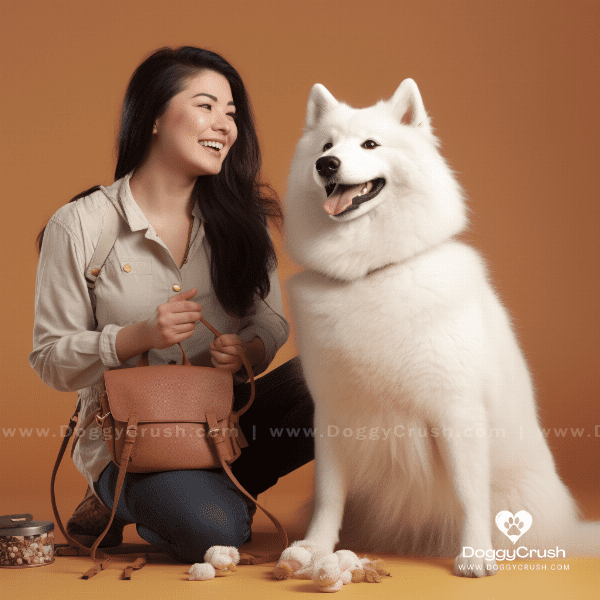
Samoyed Socialization: How to Help Your Dog Thrive
Socialization is an important aspect of raising a well-adjusted and well-behaved Samoyed dog. Here are some tips for socializing your Samoyed.
Start Early
Socialization should begin early in a Samoyed puppy’s life. Puppies should be exposed to a variety of people, animals, and environments from a young age. This helps them develop good social skills and reduces the risk of behavior problems later in life.
Positive Experiences
Make sure that your Samoyed’s socialization experiences are positive. Reward your puppy with treats, praise, and play for good behavior. Avoid exposing your puppy to situations that may be overwhelming or scary, and never punish your puppy for being nervous or fearful.
Exposure to Other Dogs
Exposure to other dogs is an important part of socializing a Samoyed. Take your puppy to puppy classes, dog parks, or other areas where dogs are allowed. Gradually introduce your puppy to other dogs and make sure that the interactions are positive and supervised.
Exposure to People
Exposure to people is also an important part of socializing a Samoyed. Take your puppy to places where they will be around people, such as parks, pet stores, or outdoor cafes. Encourage people to interact with your puppy, but make sure that they do so in a positive and gentle manner.
Ongoing Socialization
Socialization should be an ongoing process throughout your Samoyed’s life. Expose your dog to new experiences and environments, and continue to reward good behavior. This will help your Samoyed become a well-adjusted and confident companion.
Conclusion
Socialization is an important part of raising a well-adjusted and well-behaved Samoyed dog. By starting early, providing positive experiences, and continuing socialization throughout your dog’s life, you can help your Samoyed thrive and become a wonderful companion. Remember to be patient and consistent, and enjoy the process of socializing your furry friend.

Samoyeds and Children: A Match Made in Heaven?
Samoyed dogs are known for their friendly and sociable personalities, which makes them excellent companions for children. Here are some things to consider when introducing a Samoyed to a family with children.
Temperament
Samoyed dogs have a friendly and playful temperament that makes them well-suited for life with children. They are generally patient and gentle with children and enjoy playing games and cuddling with their young human companions.
Socialization
Socialization is important when introducing a Samoyed to children. It is important to expose the dog to children of all ages and sizes to help them develop good social skills. Encourage children to interact with the dog in a positive and gentle manner and always supervise interactions between children and the dog.
Training
Training is an important part of ensuring that a Samoyed and children coexist safely and happily. Basic obedience training, such as “sit,” “stay,” and “come,” can help prevent potential accidents and keep both the dog and children safe.
Exercise
Samoyeds are a high-energy breed that requires plenty of exercise. Children can help provide exercise for the dog by playing games like fetch and running around the backyard. This can also help children and the dog bond and develop a closer relationship.
Conclusion
Samoyed dogs can make wonderful companions for children when introduced and trained properly. By considering the dog’s temperament, socialization, training, and exercise needs, families with children can provide a safe and happy home for their furry friend. With patience, consistency, and love, Samoyeds and children can truly be a match made in heaven.
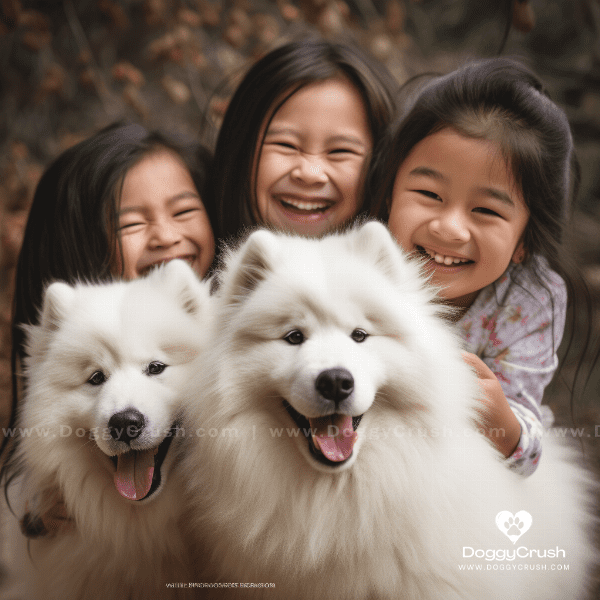
Samoyeds in Pop Culture and Beyond
Samoyed dogs have made appearances in various forms of media, from movies to advertisements. Here are some examples of Samoyeds in pop culture and beyond.
Movies and TV Shows
Samoyed dogs have appeared in several movies and TV shows, including the popular Disney movie “Snow Dogs” and the TV series “Game of Thrones.” In “Snow Dogs,” the main character, played by Cuba Gooding Jr., inherits a team of mischievous sled dogs that includes a Samoyed named Demon.
Advertisements
Samoyed dogs have been featured in advertisements for various products and brands, such as Subaru and Oreo cookies. In Subaru’s “Dog Tested, Dog Approved” ad campaign, Samoyeds are portrayed as loyal and adventurous companions that are perfect for Subaru’s outdoor-oriented customers.
Social Media
Samoyed dogs have become popular on social media platforms like Instagram, where accounts dedicated to the breed have amassed large followings. Some Samoyed accounts on Instagram have over a million followers and feature daily updates of the dogs’ adventures and antics.
Therapy Dogs
Samoyed dogs make excellent therapy dogs due to their friendly and sociable personalities. They have been used in hospitals and nursing homes to provide comfort and emotional support to patients.
Conclusion
Samoyed dogs have made appearances in various forms of media, from movies to advertisements. They have also become popular on social media platforms and have been used as therapy dogs in healthcare settings. Despite their appearances in pop culture, however, Samoyed dogs are much more than just a pretty face – they are intelligent, loyal, and affectionate companions that make wonderful family pets.
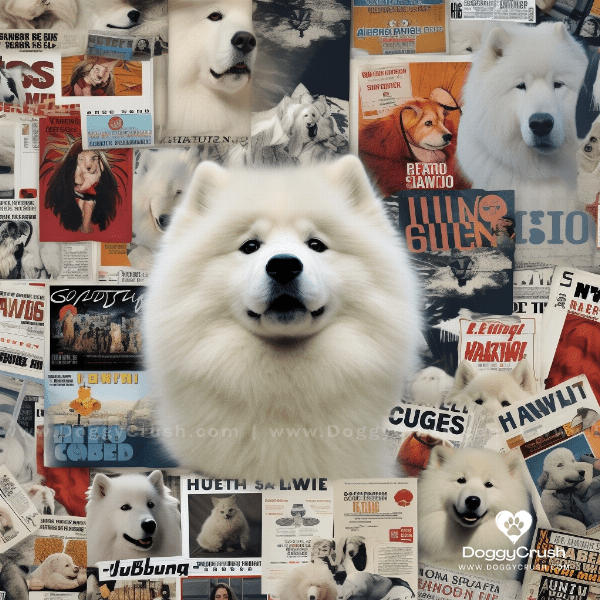
Finding Your Perfect Samoyed: Adoption, Breeder, or Rescue?
If you’re considering adding a Samoyed dog to your family, there are several options for finding your perfect furry friend. Here are some things to consider when deciding whether to adopt, buy from a breeder, or rescue a Samoyed.
Adoption
Adopting a Samoyed from a shelter or rescue organization can be a great option for those looking to provide a loving home for a dog in need. Many Samoyeds end up in shelters due to no fault of their own, such as changes in their owner’s living situation or health issues. Adopting a Samoyed can be a rewarding experience and can provide a second chance at a happy life for the dog.
Breeder
Buying a Samoyed from a reputable breeder can ensure that you get a dog with predictable characteristics and good health. However, it is important to do your research and choose a breeder who prioritizes the health and well-being of their dogs. A good breeder should provide health testing, socialization, and a clean and safe living environment for their dogs.
Rescue
Rescuing a Samoyed from a rescue organization can be a great option for those looking to provide a loving home for a dog in need while also supporting a good cause. Rescue organizations work to provide medical care, socialization, and training to dogs in need before placing them in loving homes. Rescuing a Samoyed can be a rewarding experience and can provide a second chance at a happy life for the dog.
Considerations
When deciding whether to adopt, buy from a breeder, or rescue a Samoyed, there are several things to consider, such as your lifestyle, budget, and time commitment. It is important to choose a dog that fits well with your family and lifestyle, and to be prepared for the financial and time commitments that come with owning a dog.
Conclusion
There are several options for finding your perfect Samoyed, including adoption, buying from a breeder, or rescuing. Each option has its pros and cons, and it is important to consider your lifestyle, budget, and time commitment when making a decision. Regardless of how you find your furry friend, providing a loving home for a Samoyed can be a rewarding and fulfilling experience.




